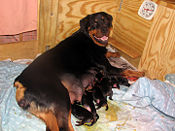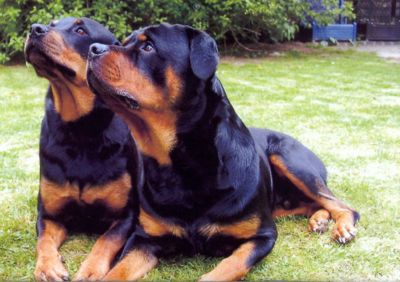Rottweiler/Citable Version
The Rottweiler is a large breed of dog known for its great physical strength and strong protective instinct. The breed was once employed widely to guard, herd, and pull carts, and its kennel club classification, usually in the working dog group, reflects this. Although still sometimes put to work, especially as police dogs, most Rottweilers today serve as human companions or family pets, where their natural instincts manifest as a strong protectiveness toward those they consider their own. The very traits that can make Rottweilers valuable can also make them dangerous, especially when owners train them to be. Proper socialization and integration into human and canine society as puppies, coupled with quality obedience training, is thought to greatly or altogether alleviate the likelihood of them posing a threat when it is unintended.
History of the breed
Origins
The legendary origin of the Rottweiler is that its ancestors were the Roman legions' canine cattle drovers - in particular, dogs left behind in what had been the Roman Provinces in Germany, when the Romans were repelled in about 200 AD.[1]
One Roman army encampment on the Neckar River, in what became the state of Swabia in southern Germany, flourished as a trading center due to its strategic location and came to be called Rottweil (from rote wil — red tile, named for fragments of red planch used for decorating Roman villas). [2] [3]Hundreds of years after the fall of Rome, the dogs of Rottweil were to become known as Rottweilers.
Just what were those early Roman dogs like? The Romans had a number of mastiff-like strains that were descended from the Molossus. Some of these were trained to fight in the arenas, while others were used for household protection. Some were bred by the travelling legions to herd the cattle used as meat for the men. The Roman soldiers, particularly in invasions, were known to be highly disciplined, relentless, and disdainful of weakness. It's hard to imagine that any dogs these troops favored as road companions were allowed to survive and breed unless they were successful in moving the cattle properly and in protecting the soldiers' beef supply.[4]The characteristic Rottweiler behavior of being both instantly obedient to a strong master yet fearlessly antagonistic towards that master's enemies are qualities that sound likely to endear a dog to a Roman legionnaire, especially if that dog - like a good Rottweiler - was stronger than a man. But were those ancient dogs like the modern Rottweiler? Is there any demonstrable connection between them?
Oral history has it that in southern Germany the Roman cattle dogs had been interbred with local dogs, and though the Romans had left, the bloodlines of their dogs became part of the local canine population. In the Middle Ages, this area became a livestock trading center and good herding dogs were likely never out of work. So, a connection is possible though not proven.
It is known that the ancestors of Rottweilers were used to drive cattle through those lands just before the coming of the railroads in the nineteenth century. With rail transport established, cattle droving across the countryside was forbidden. Many of these large dogs, however, offered utility to the meat merchants. The butchers of Rottweil used their dogs to herd cattle to market locally; then, after the cattle were slaughtered, they harnessed the dogs to the butchers' carts and used canine draft animals to deliver the meat. When the beef was sold, the money is said to have been put in a purse tied around the dogs' necks to keep it safe from thieves while the dogs pulled the empty carts back to the business place. [5] These uses made the stronger and more protective members of the breed more valuable than the lighter and smaller dogs, and it is reasonable to assume that Rottweilers became successively larger-headed and more muscular in conformation because of selective breeding in the nineteenth century aimed to improve their ability as draft and guard animals.
Are these legends true? There is no doubt that dogs existed in ancient Rome, and that dogs that looked very much like those depicted in Roman artwork were found in nineteenth century Germany, in the regions that had once been settled by the ancient Romans. The legends, then, may be true, but are not fact. Canine genes bestowing that same physical appearance might be procured from the right mix of other dogs, and so the link between the old Roman herding mastiffs and the modern German dog could only be proven with a record of continuous pedigree, one that established a direct line through thousands of generations. This evidence will never be available, as Rottweiler stud books only go back to the early twentieth century. Canine pedigrees were not recorded, as far as anyone knows, until the late nineteenth century. There are no records, in artwork or documents, that indicate that dogs that looked and acted like Rottweilers existed continuously through medieval times in Germany. So, in the absence of DNA analysis, whether these modern German dogs that so resemble the dogs in the art of Ancient Rome are direct descendants of those Roman dogs is likely to remain unproven. Doubtless, though, this breed was found in Rottweil, Germany; a part of Ancient Rome, in the past, in an area used to breed cattle.
Europe
The first Rottweilers were shown in Germany in the late nineteenth century, and by 1899 were being both "bred and exhibited on a systematic basis."[6][7]Rottweilers were a rare breed in Germany in the early part of the twentieth century, not as established or populous there as the German Shepherd Dog or Doberman Pinscher. Those latter two breeds were used especially for police work.[8] However, in later years, the Rottweiler breed would become recognized for special excellence in police work.
The first breed standard was written in the early twentieth century in Germany, and the first club dedicated to the breed was also German: the DRK (Deutscher Rottweiler Klub). Within a few years, a number of rival clubs were established in the country, which by 1924 began to collaborate on a single stud book for the breed.[9] In those early years, although the Rottweiler was a recognizable breed, there was more variation in color and conformation than would be accepted by the newly established standards. White spotting, for example, was common but would soon be reduced and eliminated. Some of the early Rottweilers had heads more like pointers than is now acceptable. Since several of the officials and breeders of that era remarked that the dogs were like the herding and cart dogs of southern Germany they had owned in previous decades, there is a record that the dogs shown in the 19th century were relevant to the twentieth century Rottweiler.
A system of wardens oversaw the breeding of Rottweilers in Germany during the 1930s. These wardens inspected dogs, bitches and litters and had the power to refuse registration of the offspring of animals who had produced poor quality progeny. This policy is certainly in line with ethical dog breeding, but it co-existed with the Nazi Germany policy of eugenics, where the seeds of genocide were planted by the philosophy of a master race of humans achievable by human eugenics. As the German government changed into a totalitarian system, the wardens were no longer directed by the dog fanciers but instead were overseen by the 'National Association for Canine Matters' which was, itself, under the direct control of a government ministry. As the military rose to increasing importance, the breed standards suggested by these officials did not look to better and refine the traditional Rottweiler, but to change the breed into one more suitable for the courier dogs that the military forces required. However, the dog fanciers of southern Germany, the region that first gave rise to the breed, successfully opposed the breeding of the lighter-bodied animals favoured by the military.
England
In the UK, the breed was first shown at Crufts in 1936, and in 1966 a separate register was opened for them.
North America
The first Rottweiler was admitted into the AKC register in 1931. According to the American Rottweiler Club, it remained a rare breed for some time, but began to increase dramatically in the 1980s. The Rottweiler has been the second most popular AKC dog breed since 1992. [10]
The United Kennel Club recognised the Rottweiler in 1950. There is also an organization for working Rottweilers under the auspices of the United States Rottweiler Club, a member of the American Working Dog Federation, which follows the FCI standard.
Current breed standard
Robust and muscular, these dogs are not squat. Large, but not giant, they are typically 55-69 cm high at the shoulder, and weigh between 90-110 pounds. Rottweilers show what is called sexual dimorphism: there are 'two forms', one for each sex (or gender). Male Rottweilers are generally taller and heavier, and there are also differences in the facial features. Female Rottweilers are not delicate, but do have a more feminine[11] appearance than males.
A black coat with red-brown markings in a characteristic mask is a hallmark of the breed. There are three accepted shades of the reddish contrasting color: mahogany, rust and tan.
The Rottweiler's tail was traditionally docked in Germany, but currently docking of the tail is not advocated in the European Union. In the United Kingdom, the procedure must be performed by a veterinarian. Legislation varies among Australian states, but most require that docking should only be performed by a veterinarian, in the best interests of the dog. In the United States, the tail is routinely amputated.

|

|
| Dam in her whelping crate. | First day of life for the new litter. |
Field Tests
Although Rottweilers are not classed as herding dogs by modern kennel clubs, and despite not having been selectively bred to herd for many generations, the breed still produces puppies that can be trained to be good herders. Rottweilers are one of the few working dog breeds eligible for field competition in livestock herding by the AKC and some other kennel clubs.
Breed-specific legislation
The Rottweiler has sometimes been targeted for what is generally referred to as breed-specific legislation, that is, legislation affecting one breed, group or type of dog, but not others. The specifics of the regulations can differ greatly from country to country and even between different jurisdictions in the same nation.
In the case of the Rottweiler, breed-specific legislation usually describes them as being inherently dangerous dogs. Some of these laws restrict breeding and ownership of Rottweilers, others require that Rottweiler owners have insurance not required for the owners of other dog breeds. Dog fancy and kennel clubs routinely resist this type of discrimination.
- See the main article at breed-specific legislation.
Are Rottweilers inherently dangerous dogs?
Rottweilers are very strong dogs, easily able to knock a full-grown and muscular man to the ground. This strength makes the dog an excellent police dog, as well as a rescue dog – with the right training. 'Rotties' are predisposed to inherit a territorial instinct and to discriminate between known 'family' and 'strangers'. The breed is also known for its intelligence, and is characterized as one of the breeds of dog that is able to learn commands after only a few trials. Despite their size, fully-grown Rottweilers are also surprisingly fast and agile.[12]
Its temperament, in combination with physical prowess, makes the dog a natural watchdog for the home. However, when the dog is not properly socialized, these very same attributes can lead to serious injuries and even death to human beings who invade the dog's territory without an 'introduction' from the owner. Such a risk is greatest if the dog is physically touched despite its warnings to stay away. When powerful dogs with such a temperament are raised in isolation from human society, and are either not handled sufficiently during their first months of life by any person, or actually abused and taught to attack people and other dogs - then indeed, the Rottweiler, like almost every one of the working breeds, is dangerous. A good and typical specimen of the breed has the physical power of body and limb to bring down a man, a lacerating bite, and an instinctual capability to attack large prey in a lethal manner.
Rottweilers are threatening in a manner that smaller and weaker dogs are not. A toy terrier may regularly growl at, and even snap at or actually nip, visitors to the home. That behavior may be annoying, but a 120-pound Rottweiler behaving in the same way would not be perceived in the same manner, and, if allowed to nip, would be more than an annoyance. Unlike toy terriers, poorly socialized Rottweilers cannot be tolerated in human society. The organized clubs of Rottweiler fanciers throughout the world urge responsible ownership of these dogs, which includes a commitment to socialization of puppies and to obedience training.
References
- ↑ "The origin of the Rottweiler is not a documented record. Once this is recognized, actual history tempered by reasonable supposition indicates the likelihood he is descended from one of the drover dogs indigenous to ancient Rome. This drover dog has been described by various accredited sources as having been of the Mastiff-type-a dependable, rugged, willing worker, possessed of great intelligence, and a strong guarding instinct." Sourced from the American Kennel Club site: http://www.akc.org/breeds/rottweiler/history.cfm on 20th November 2007.
- ↑ Hans Korn, Rottweiler breed history, sourced at: http://www.der-rottweiler.com/menu1_01.html on 20th November 2007
- ↑ "It is said that Rottweil was so named around the period of 700 A.D., at the time that a Christian Church was erected where formerly had been Roman baths. During the excavation, red tiles of an earlier Roman villa were unearthed, and soon the area became known as "das Rote Wil" or "the red tile." The History of the Rottweiler in The Book of the Rottweiler by Anna Katherine Nicholas.
- ↑ While the exact and specific use of large dogs as droving animals is speculated about and debated, Romans' general use of dogs as hunting and battle companions is described in their literature and art and is generally accepted. Pliny the Elder describes differing dog types in his Natural History.
- ↑ Korn, op. cit., affirms the use of the "butcher's dog" (Rottweiler Metzgerhund) and suggests that other merchants used these dogs as cart pullers as well.
- ↑ Pettengell J. The New Rottweiler ISBN 0793800803, page 16.
- ↑ The website of the American Kennel Club states: The annals of cynology make no further mention of the breed until 1901 when a combined Rottweiler and Leonberger Club was formed. This Club was short-lived but notable because the first Rottweiler standard appeared under its auspices. It is of value for us to know that the general type advocated has not changed substantially and the character called for, not at all. Sourced at: http://www.akc.org/breeds/rottweiler/history.cfm American Kennel Club - Rottweiler History], 24th September 2007.
- ↑ Kennel Department; The Police Dog Forest and Stream; A Journal of Outdoor Life, Travel, Nature Study, Shooting, Fishing, Yachting (1873-1930). New York: Feb 24, 1912. Vol. LXXVIII, Iss. No. 8, 256-9.
- ↑ Several clubs were organized as dissension was most common until 1921 when it was agreed to form the Allegmeiner Deutscher Rottweiler Klub (ADRK). By that time, 3,400 Rottweilers had been registered by three or four clubs. Duplications and confusion ended when the ADRK published its first stud book in 1924. Website of the AKC, op. cit., sourced on 24 September 2007.
- ↑ Sourced at the website of the American Rottweiler Club, http://www.amrottclub.org/rottweilers.htm, 24 September 2007.
- ↑ This is not necessarily anthropomorphism: breed standards often describe dogs as having a "masculine" or "feminine" appearance
- ↑ News.com.au: 'Fast dog dodges 12 police bullets'. 3rd October 2007.
- Pages using ISBN magic links
- Subpages
- Biology Extra Subpages
- Hobbies Extra Subpages
- Dogs Subgroup Citable Versions
- Biology Approved Extra Subpages
- Hobbies Approved Extra Subpages
- Citable versions of articles
- Biology Citable Version Subpages
- Hobbies Citable Version Subpages
- All Content
- Biology Content
- Hobbies Content
- Hobbies tag
- Dogs tag

